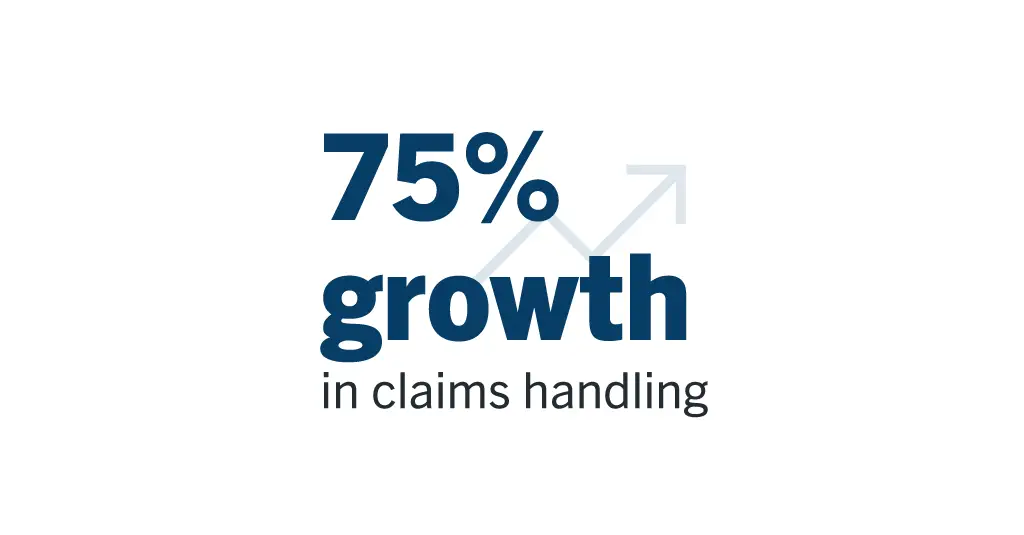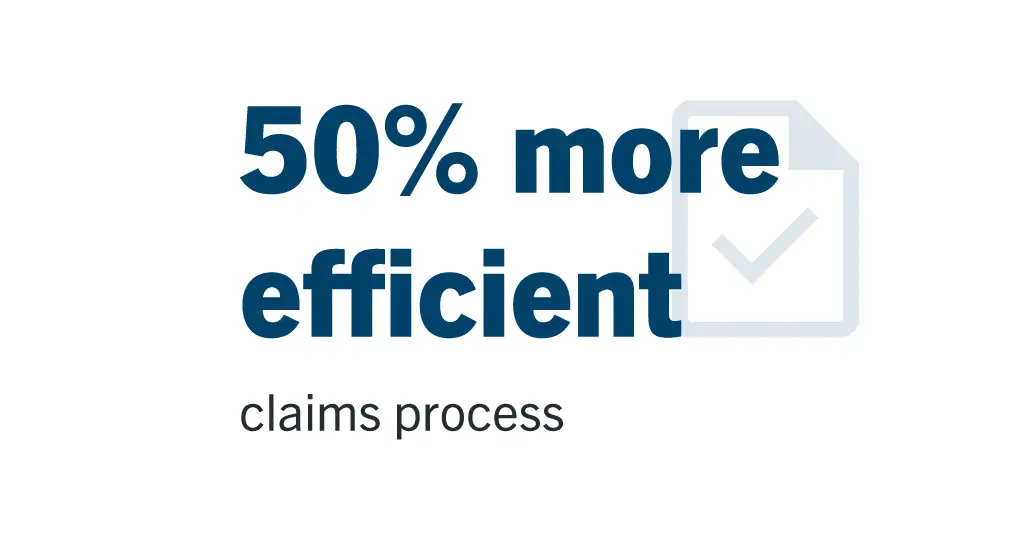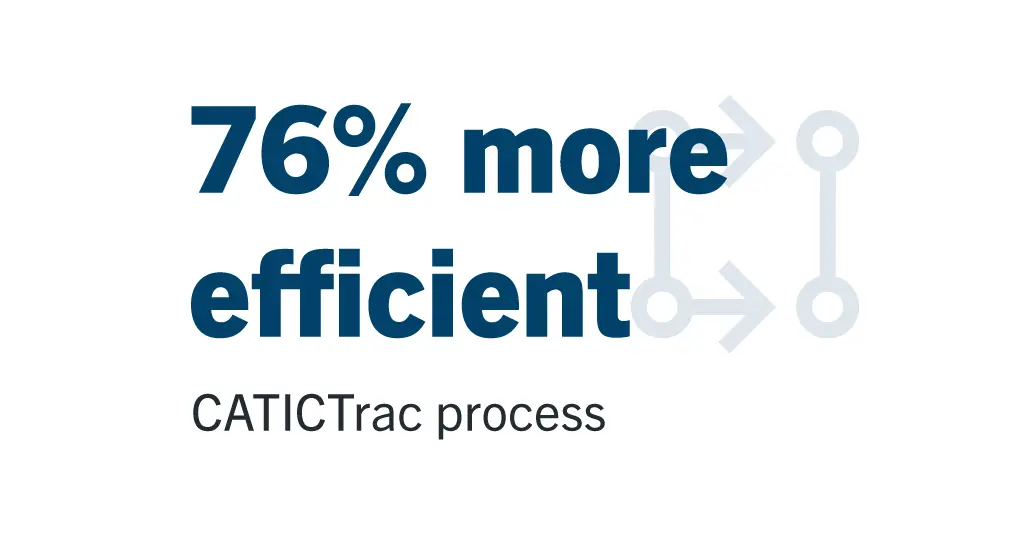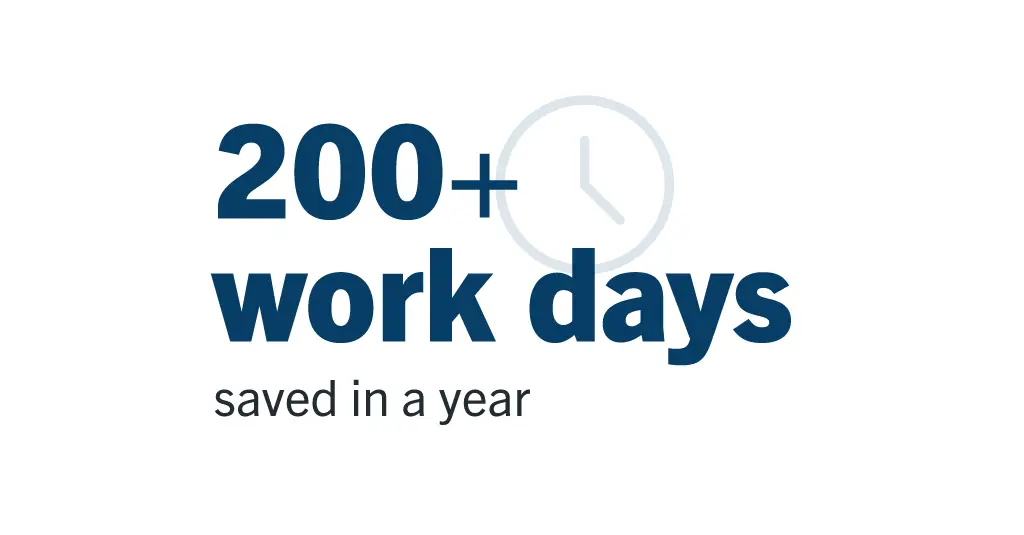- Products
-
-
Product Features
-
Explore More
-
-
- Solutions
-
-
By Industry
By Department
-
By Business Need
-
-
- Learn & Support
-
-
Product Education
-
Product Support
-
-
- Resources
-
-
Insights
Events
-
-
- Partners
-
As one of Mexico’s leading insurance companies specializing in property, casualty and civil liability insurance, GMX Seguros has prioritized operational excellence and customer experience. Facing the perennial challenges of paper-intensive processes, escalating compliance demands, and the critical need for rapid claims resolution, the insurer sought to replace a legacy document management system with a more robust solution.


The insurer found a solution in Laserfiche, embarking on a journey that has dramatically streamlined operations, cut processing times, and fortified GMX’s position as a market leader. Through the organization’s automation initiatives, the insurer achieved an impressive 75% growth in claims handling capacity and a 20-30% increase in other business areas.
Before adopting Laserfiche, the GMX grappled with a complex web of manual processes and physical documentation. Policy issuance, regulatory compliance and claims handling were bottlenecks that hindered efficiency and customer satisfaction.
“We were generating a lot of paper in different ways,” said Oscar Salgado, CIO at GMX Seguros, describing the sheer volume of paper as about the size of a two-bedroom apartment. This physical footprint wasn’t just about space; it translated into slow, laborious workflows. The claims process, a cornerstone of customer trust, was particularly impacted.
“Claims processing used to take more than 15 days,” Salgado said. Longer timelines in claims processing, however, test customer patience in their time of need.
Beyond operational inefficiencies, the company faced stringent regulatory requirements, such as those from the Comision de Seguros, demanding meticulous collection and secure storage of sensitive customer documents (IDs, proofs of address, financial statements) to comply with anti-money laundering regulations. Managing these crucial personal documents across disparate systems was a significant hurdle.
The insurer began implementing Laserfiche with a focus on policy management, digitally archiving all issued policies and integrating them with a customer portal for easy download. This initial success paved the way for more expansive applications.
A key area of transformation was regulatory compliance. “We need to collect IDs, address, proofs of address, statements — all these documents are personal and sensitive data,” Salgado said. “We store them in Laserfiche, and this helps us organize all the documents within our customer folders.” The centralized, secure repository became indispensable for managing sensitive data and demonstrating compliance.
The most significant impact, however, was felt in claims. The company developed a digital claims solution, which collects all necessary documents from customer and automatically builds a digital file. The GMX team built an integration between Laserfiche and the company’s claims system via Laserfiche API which links every claim document to its corresponding policy and customer file, creating a comprehensive digital record.
The insurer’s use of Laserfiche extends to other departments and critical processes including:
The implementation of Laserfiche yielded immediate and profound benefits, most notably in time savings and operational efficiency.

“The time that we are saving is tremendous,” Salgado explained. The most striking improvement was in claims processing: “Claims that used to take more than 15 days now less than five. In some cases, we can process a claim within the same day.”
This strategic advantage became especially evident during a crisis, when GMX experienced an influx of claims in a short period of time. In 2023, Hurricane Otis made landfall near Acapulco and became the costliest tropical cyclone to strike Mexico on record.
“We had the best turnaround time for claims related to Hurricane Otis,” Salgado said. While competitors struggled to process claims for months, the GMX Seguros’ Laserfiche-powered processes allowed the insurer to pay customers in less than a month. “With this efficiency, we can process more claims in less time.” This increased capacity, he added, amounts to 75% growth in claims handling.
Handling 50,000 – 60,000 claims per year and issuing more than 300 policies per day, GMX employees use Laserfiche on a daily basis to support critical service delivery. Beyond claims, the insurer has experienced 20% – 30% growth in other business areas.
GMX has also implemented Laserfiche to increase efficiency in:
The importance of the company’s standardized document management and automated processes is further magnified by audits, which are done internally as well as by regulatory entities. “We use Laserfiche to review and compile all documentation needed for audits, which used to be a very time consuming process,” Salgado said.
The paper reduction has also liberated valuable physical resources, freeing up office space and allowing for better utilization of facilities.
GMX Seguros has not only automated critical processes like claims, compliance, and policy management but has also built a resilient, highly efficient digital ecosystem. The ability to dramatically reduce claims processing times has translated directly into enhanced customer satisfaction, particularly when responding to high-volume events like natural disasters.
“We have some of the best response times in Mexico,” Salgado said. “Laserfiche is not just a document storage system for us. It’s a competitive advantage.”
In today’s rapidly changing insurance landscape, insurers face mounting pressures from economic and environmental uncertainty, coupled with rising policyholder expectations. Navigating these challenges means they need to improve how they operate, enhance customer experience and manage compliance costs. A recent industry survey, however, revealed a problem: Many insurers aren’t set up to tackle these strategies effectively. In fact, over half of them cited data fragmentation as their top operational hurdle.
Insurance companies continue to rely on inefficient data collection such as paper-based forms and static PDFs, forcing policyholders into tedious, error-prone data submissions. These outdated processes lead to manual data entry, repeated follow-ups, and inconsistent service. As a result, customers churn and bring down net promoter scores (NPS). Meanwhile, policyholder data is scattered across line-of-business applications, forcing staff into a “swivel chair” routine as they search for crucial data. This disconnected approach not only delays decision-making but also creates significant operational inefficiencies.
At the same time, insurers are grappling with increasing volumes of data from connected devices like telematics, smart home systems, and wearables. While this influx of data represents a tremendous opportunity to tailor policies and set accurate premiums, many insurers lack the capabilities to capture business-critical metadata efficiently.
Harness Your Data: From Overwhelmed to Supercharged
So, what can insurers do to turn data into business intelligence? The answer lies in embracing an enterprise content management (ECM) system as a unified source of truth and data orchestration engine.
With an ECM as the data backbone, insurers can:
Leading ECM systems also incorporate generative AI features with the potential to revolutionize the way insurers intake claims, policy updates, and service requests from multiple channels.
These strategies not only improve productivity and cut costs but also elevate the overall policyholder experience – a vital factor in today’s competitive market.
Ready to learn how to turn data into strategic actions with an ECM platform? Download our free whitepaper, “Connect the Dots and Unlock the Power of Data in Insurance,” to discover how AI-powered data management can unlock the full potential of your data and lead your organization into a more efficient, customer-centric, data-driven future.
SITUATION
• Reliance on manual, paper-heavy processes
• Legacy document management system did not provide intelligent capture, process automation or integration capabilities
RESULTS
• Migrated content to Laserfiche and automated processes including CATICTrac service, records management, claims and compliance
• Saved over $325,000 annually
• Created up to 90% more efficiency in some processes
• Increased capacity without creating the need to hire more staff
CATIC is one of the largest title insurance companies in the United States. The organization has been a trusted resource for policy-issuing attorneys, insured lenders and homebuyers, and other members of the real estate community for over 50 years.
The organization offers a number of services, including underwriting consultation, title information products, legislative and case law reporting, release tracking, flood compliance and more. CATIC’s approach is one of continuous improvement, constantly looking to improve efficiency in operations to maintain its strong reputation for high-quality service.

Using continuous improvement methodologies and the Laserfiche content services platform, CATIC has digitally transformed many of its processes.
Benefits include:

To date, the organization’s efforts have resulted in cost savings of over $325,000 annually. Additionally, CATIC has seen a nearly 50% increase in efficiency in both customer-facing processes, such as claims, and back-office operations, including records management.
Like many organizations, CATIC previously relied on manual, paper-heavy processes. Unsatisfied with the status quo, CATIC Senior Operations Analyst Chris Cooper had a vision to optimize the way the organization managed information. He and his team sought out a platform that would support more efficient, automated processes.
This search led to Laserfiche, which satisfied CATIC’s requirements for a system to centralize content and support information governance — while opening doors to workflow automation, which wasn’t available with the legacy system. Following continuous improvement practices, Cooper saw the opportunity to improve:
CATIC partnered with Laserfiche solution provider Accelerated Information Systems (AIS) to implement Laserfiche — starting with migrating content from the organization’s legacy system.
The first workflow the CATIC and AIS teams automated was for the company’s CATICTrac service, which tracks, obtains and records the appropriate documents needed to clear liens. The automated process eliminates the need for clients to submit paper forms, which can be cumbersome, error-prone and lead to delays. Instead, clients submit an electronic Laserfiche form, which automatically routes information to the appropriate personnel for review and approval.

Using the Laserfiche-driven solution, CATIC was able to simplify the process from 12 steps down to five and improve efficiency in the process by 76%. Cooper estimates that the CATICTrac workflow alone saves the organization over $84,000 per year.
After the initial success with CATICTrac, Cooper and his team expanded the use of Laserfiche into other areas of the business, including records management, claims and compliance.
Digitizing records and automating records management processes was an impactful initiative that had a profound effect across the enterprise. By centralizing content in Laserfiche, CATIC created a robust information backbone for the organization that is searchable and accessible, while maintaining the granular access controls needed to support information governance. When policies are filed, they are now immediately available for processing, rather than the next morning as was with the legacy system.
This also streamlined the policy request process when stakeholders needed to pull policies, for example for finance to recognize revenue; if a claim was ever filed against the policy; or if a modification needed to be made to the policy. Requests to pull policies previously resulted in wait times of around 11 days, which have been shortened to six. The first-time quality of information pulled has also increased by more than 10%. Finally, the entire initiative has simplified activities for stakeholders, who pull an average of 150,000 policies per year.
In claims, the goal was to simplify and standardize the process, cutting down wait and processing times while increasing the quality and capacity for claims. Using Laserfiche, Cooper automated the process and reduced the number of steps to process a claim from 27 down to 11. The processing time for a claim is now 50% more efficient, with a 5% boost in, first time quality. The elimination of paper in the process also saved CATIC over $25,500 per year.
CATIC isn’t stopping there, however, and is currently pursuing an integration between legal management solution CounselLink and Laserfiche that will make the process even more efficient. Today, claims are filed through Laserfiche Forms, which allows claimants to input necessary information and upload supporting documents. Laserfiche then sends the supporting documents to CounselLink. “Phase two is about eliminating keystrokes,” Cooper said. “With the integration, all of the data entry that claimants are putting on the notice of claim form will be pushed into CounselLink, because paralegals are currently rekeying that data.”
Cooper’s continuous improvement approach has been embraced internally, too, within the compliance department. Each year, employees must acknowledge that have read and agree follow company codes and policies, which is now done through a Laserfiche form.
“We launch this project every year, and every year we make changes,” Cooper said. “This is probably the most picture-perfect example of continuous improvement. Every year it gets more and more efficient.”
The previously paper-driven, manual process would take about 60 days, while today it takes just 15. The Laserfiche form has cut down the amount of time employees need to spend with the document, making it 90% more efficient.
As a result of these systematic improvements, CATIC saves over $325,000 annually, while also supporting information governance and compliance practices and policies and enhancing the customer and employee experience.
Cooper continues to make updates to existing processes and find new areas to improve efficiency and productivity across the organization. “With new Laserfiche processes, as more work comes in the door, we now have the ability to increase units completed or throughput,” Cooper said. “And the whole industry has moved toward focusing on profitability per unit. So, we’re able to also facilitate growth without having to hire more staff.”

In the works are integrations with financial management and accounting software Sage Intacct that will allow for easier reimbursement requests, and an integration with Microsoft Power BI to create a dashboard for policy issues that agents and senior management can view and address any missing information.
Cooper is also working to use Laserfiche’s process automation capabilities to sync information from an FTP site daily so he doesn’t have to do it manually. “The bot is like a personal assistant,” he added.
“Laserfiche is something I felt that I could be great at, but also could help me to help others be great,” Cooper said. “I see that as a powerful tool. I enjoy making processes better and I feel Laserfiche is the most powerful thing I’ve encountered, where I could achieve my own personal goal of helping others achieve their goals.”
The focus on customer experience was one of the core drivers in the process automation strategy for MSIG Hong Kong (MSIG), embracing customer needs in light of a shifting technological landscape and major disruptions. The company sought to phase out legacy systems and increase efficiency for its claims submission service, requiring a highly adaptable content services tool to do so.
Since implementing Laserfiche for claims in 10 different product lines, the MSIG claims team can now manage all claims in a centralized platform, allowing staff to focus on more important claim assessment tasks. By investing in digital transformation for the organization’s EASY Claims System, MSIG has been able to differentiate itself in Hong Kong’s highly competitive insurance industry. The organization’s EASY Claims system has received wide recognition in Asia’s insurance landscape, as well as won MSIG a number of industry awards. In 2019, the company won a Laserfiche Run Smarter Award; in 2024, MSIG earned the Laserfiche Run Smarter Award for Best Program ROI.
“Laserfiche is the catalyst for our users and customers to improve their day-to-day work experiences,” said Alan Yue, Senior Vice President of Information Technology at MSIG.
Seeking a means to respond to customer needs and enable staff to transition to remote working arrangements, Laserfiche has also helped MSIG successfully achieve business continuity, maintaining a high level of operational efficiency and customer service through dedicated portals.
Providing general insurance solutions for more than 100 years, MSIG Holdings (Asia) Pte. Ltd. has a history of combining global and local best practices in the organization’s customer-focused approach, believing that the relationship between insurance companies and customers should be based on trust. This commitment to customers led the organization to reassess its reliance on manual legacy systems for process management. MSIG recognized that customers are embracing more digital solutions, presenting an opportunity to make correspondence with clients more seamless and efficient, as well as reengineer the IT infrastructure.
“As a core part of our business, the claims system is one of the most important parts of the MSIG customer journey,” Yue said. “We realized that the entire process was actually quite paper-driven, making it the perfect candidate to digitalize and automate.”
MSIG initiated a business transformation program known internally as “Transformer” in 2017. Laserfiche was chosen as MSIG’s core digital transformation solution with the goal of automating manual and paper-based core business processes, targeting the customer claims submission platform as a starting point. Eventually named EASY Claims, the system improved both operational efficiency and service with a focus on the customer experience. The platform supports self-service submissions, as well as provides transparency of claims status to MSIG customers.

Within the first three months of launch, EASY Claims significantly improved efficiency at MSIG, automating over 100,000 tasks that previously required manual user input.
Additionally, the number of clients submitting claims via the new system has increased by up to 80%. This has streamlined and simplified the claims submission process for customers, aligning with shifting technological expectations and improving response times.

The EASY Claims system also improved the experience for staff processing customer submissions. Originally, acknowledging a newly submitted claim could take two days. Today, it takes fewer than 15 minutes. This translates to a savings of more than 200 work days a year for the claims processing staff organization-wide. The property claims management team specifically was able to save 57 days a year through the EASY Claims system.
The initiative has created the opportunity for ongoing optimization. In 2022, MSIG introduced Zero Touch for Helper insurance plan claims. Zero Touch is MSIG’s digital solution for claims assessment, enabling customers to submit their claims form, supporting documents and contact details online. The system then checks the customer’s claims history, policy validity and claim payment amount. For eligible clinical or dental expenses claims, payments are settled in just two working days. MSIG is planning to add Zero Touch to more products, creating a more seamless customer experience across product lines.
Along with facilitating claims submission for customers and acknowledgement in the backend, the automated process has helped save 12 days a year during the claims finalization stage. In terms of improved staff efficiency, MSIG has increased overall productivity by 1.4 times per hiring cycle within the Claims department alone. As a team with a significant amount of customer facetime and interaction, the Claims department’s increased productivity has improved both employee and customer experience.
In 2022, MSIG Hong Kong honored over HK$356 million, with a claims ratio of 92.9%, seeing a consistent increase for three consecutive years. The organization also reduced the number of complaints received by 50% in two years.
As the platform that powers the EASY Claims system, Laserfiche has helped to ensure a high level of customer service and a user-friendly, customer-oriented interface. The platform removes friction from the process of filing a claim, with intuitive features such as a “save-as-draft” function that enables customers to retrieve incomplete forms at any time using an email link, and smart suggestions that provide basic information and documents that customers will need to make a claim before they fill out the form. Customers can also receive SMS messages, email confirmations and tracking numbers to stay informed of the status of their claims.
“Claims is only the beginning of our digital transformation. Since implementing Laserfiche, we are looking at expanding to multiple channels, underwriting teams and core business processes to digitize and automate as well,” said Yue.
Recognizing that the insurance industry has historically relied on legacy processes, MSIG looked to digitize its claim service, rebuilding it to address both staff and client needs. With core business processes established between 10 to 20 years prior, the firm had an intimate knowledge of its users’ needs, refreshing a part of its business that focused heavily on customer and employee input. Working with Laserfiche to develop a nimble IT strategy, MSIG has been able to improve the customer and back-end experience within the claims process without disrupting day-to-day operations.
“Both business and technology landscapes have experienced so much rapid change and development,” said Yue. “These are the primary driver for MSIG’s digital transformation program, equipping us to anticipate our future needs as well as our customer expectations.”
Experiencing unprecedented and unanticipated changes in 2020, the EASY Claims System has proven itself to be highly adaptable, highlighting the need for digital transformation at MSIG. With claims as an obvious starting point, MSIG is looking to expand Laserfiche to other departments and processes. The organization is preparing to introduce claims process tracking for customers, allowing customers to track their claims in real time through the MSIG app or website — further enhancing visibility and continuing to build trust with customers.
“We now have a way to differentiate ourselves within Hong Kong’s insurance marketplace,” said Yue. “Laserfiche has helped users throughout the company to identify opportunities to improve day-to-day work. The sky is the limit.”
To learn more about how Laserfiche drives digital transformation, schedule a consultation today.